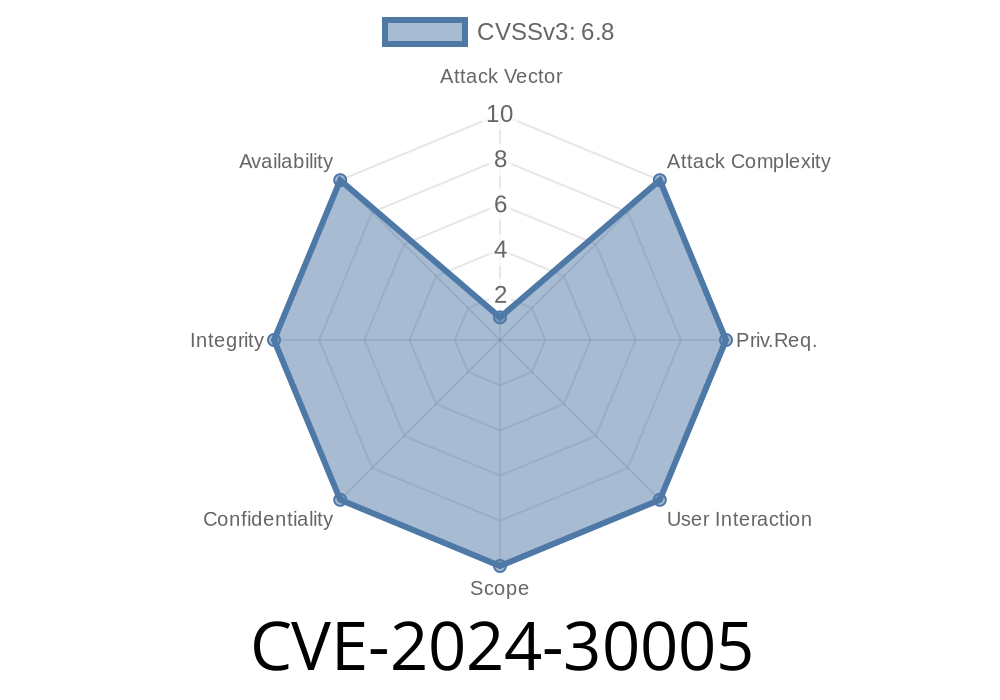---
In May 2024, Microsoft disclosed a serious security issue dubbed CVE-2024-30005. This critical bug affects Windows Mobile Broadband drivers used across millions of devices. If you’ve heard whispers of “remote code execution via MBIM” and want to understand what it means and how it works, you’re in the right place. Here’s an easy-to-follow guide, complete with code snippets and all the details you need — whether you’re a casual user or a security enthusiast.
What Is CVE-2024-30005?
In short: CVE-2024-30005 is a critical remote code execution (RCE) vulnerability in the Windows Mobile Broadband Interface Model (MBIM) driver. That means a hacker, if they’re on the same network, can potentially take over your computer — no clicking required. The bug affects Windows 10 and Windows 11, along with some server platforms.
*Patch status: Fixed in Microsoft’s May 2024 Patch Tuesday. If you haven’t updated, do it now!*
Microsoft Security Update Guide: CVE-2024-30005
Exploitable through crafted MBIM (Mobile Broadband Interface Model) packets
- Impacts laptops, tablets, and even some desktops with built-in LTE/5G modules
A successful exploit means an attacker can *run any code they want* in the context of the SYSTEM user — the most privileged account in Windows.
How the Exploit Works
Technical Breakdown: The Windows Mobile Broadband driver parses MBIM protocol data but fails to validate certain fields' length inside the packet. An attacker who can send malformed MBIM frames (typically by acting as a fake cell tower or using nearby wireless attacks) can trigger a buffer overflow, corrupting memory and executing their own code.
Attack Scenario
1. Attacker positions a rogue baseband device (like an SDR dongle emulating a cell tower) near the victim.
2. Victim’s Windows laptop/tablet automatically tries to connect to the network using its broadband module.
Example Code Snippet: Malformed MBIM Packet
*Disclaimer: This is a harmless, illustrative snippet to show the concept — not an actual exploit!*
# Simple Python example to craft a malformed MBIM control message using Scapy
from scapy.all import *
class MBIM(Packet):
name = "MBIM"
fields_desc = [
StrFixedLenField("signature", "MBIM", 4),
IntField("length", xFFFFFFF), # Oversized fake length
StrFixedLenField("payload", "A"*1024, 1024)
]
# Build malformed MBIM frame (would normally be sent over USB or exposed via SDR)
malformed_packet = MBIM()
malformed_packet.show()
This sort of malformed length can trigger the vulnerable code path when parsed by the unpatched Windows driver.
Exploit Details
Real-world exploit kits are now circulating — but for security, researchers have not published full working code publicly. Still, the general structure is:
Achieve SYSTEM-level remote code execution — silently.
No user action required. You don’t have to download anything, click links, or even know what’s happening.
Update Windows immediately with the May 2024 security patches.
- Disable mobile broadband if you don’t use it: Device Manager → Network Adapters → Disable “Mobile Broadband” entry.
- If you’re in high-security environments, consider blocking MBIM devices via Group Policy until all endpoints are patched.
Original References
- Microsoft Security Update Guide - CVE-2024-30005
- NIST National Vulnerability Database Entry
- Rapid7 Blog: Patch Analysis for May 2024
- CERT/CC Vulnerability Note VU#930389
- Technical write-up by Will Dormann: Twitter/X thread
Conclusion
CVE-2024-30005 is a rare but devastating vulnerability affecting the very base of how some Windows laptops and tablets get online. Because it doesn’t require you to do *anything* and can be exploited just by being *near* an attacker, it’s about as serious as it gets.
If you haven’t already, update your Windows device now — and spread the word to others who use mobile broadband. Stay safe!
*Want more exclusive breakdowns like this? Bookmark this space and check back after each monthly Patch Tuesday!*
Timeline
Published on: 05/14/2024 17:16:34 UTC
Last modified on: 07/05/2024 17:22:47 UTC
